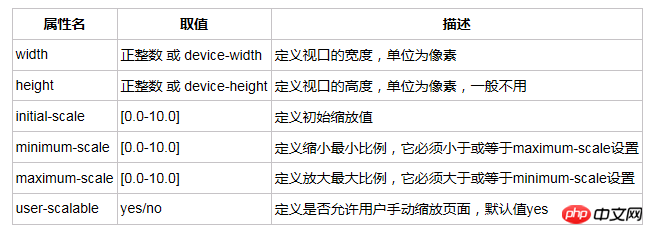
This article mainly introduces a summary of the four methods of adapting HTML5 mobile pages to mobile phone screens. It is of great practical value. Friends in need can refer to the following
1. Use meta tags: viewport
is a commonly used method for H5 mobile page adaptation. Theoretically, using this tag can adapt to all screen sizes, but the interpretation and support of this tag by each device The varying degrees result in incompatibility with all browsers or systems.
viewport is the visible area of the user web page. Translated into Chinese, it can be called "view area".
Mobile browsers place the page in a virtual "window" (viewport). Usually this virtual "window" (viewport) is wider than the screen, so that each web page does not need to be squeezed into a small size. In a window (which would break the layout of webpages that are not optimized for mobile browsers), users can pan and zoom to see different parts of the webpage.
viewport tag and its attributes:
##Copy code
The code is as follows:Detailed introduction of each attribute:

2. Use css3 units rem
rem is a new relative unit (root em, root em) in CSS3. When using rem to set the font size for an element, it is a relative size, but it is only relative to the HTML root. element. Through it, you can adjust all font sizes proportionally by modifying only the root element, and you can avoid the chain reaction of compounding font sizes layer by layer. Currently, all browsers except IE8 and earlier versions support rem. For browsers that do not support it, write an additional absolute unit declaration. These browsers ignore font sizes set with rem. Here is an example:p {font-size:14px; font-size:.875rem;}
Html{font-size:62.5%(10/16*100%)}
3. Use media query
Media query It is also a CSS3 method. The problem we want to solve is to adapt to the mobile phone screen. This media query was born to solve this problem. The function of media query is to set different css styles for different media. The "media" here includes page size, device screen size, etc. For example: If the browser window is smaller than 500px, the background will change to light blue:@media only screen and (max-width: 500px) { body { background-color: lightblue; } }
4. Use percentages
Percentage refers to the parent element, and all percentages are like this. If the width of the child element is 50%, then the width of the parent element is 100%; So the default width of the body is the screen width (in PC, it refers to the browser width). The descendant elements can be positioned by percentage (or specify the size). , this is only suitable for pages with simple layouts, and it is difficult to implement complex pages.The above is the detailed content of Introduction to several methods of implementing HTML5 to adapt to mobile terminals. For more information, please follow other related articles on the PHP Chinese website!




